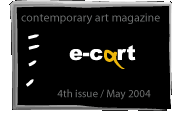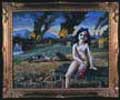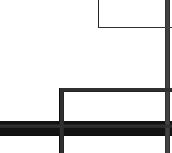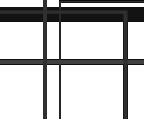























Like a birthday cake with too much cream and colored candies seemed to me the exhibition "When love turns to poison" from the cultural center Bethanien. But interesting for me was not in the first hand the exhibition itself, but the carnivalesque event that it occasioned and, most of all, the people that populated it, gathered around a new Berlin relish, like some curious and greedy children
The spoiled, normed and canonized subculture of the passionate clubbers conquering in Berlin any event affined to them, it is for me, in many cases, an aesthetic show much more attractive than the sophisticated, elitist, sterilized art celebrated with parsimony on an official dais. I'm not referring here at the quality of works in itself, but to the social happening that they give birth to.
In such occasions the "Gesamtkunstwerk" is translated by a framing up. The eloquence wants itself exhaustive: the art works are comfortably installed in the club, the assorted DJ's are for nothing alarmed, a performance is produced ad hoc, the VJ is screening on the walls his/her latest video works, a bar is improvised in the wardrobe and the spirits can freely unfold, at any level, in a cultural party.
A certain styled eccentricity accompanies now such events. It witnesses about the coming at the surface of an initially underground tradition and its comfortable settlement in plush armchairs. In the industrial sets of the illegal techno parties of the end of the '80 ies, the beginning of the '90 ies: old factories, bunkers, deserted houses, barren holls, hallucinogens were created, their virtues were experimented, a new art was invented for a new chemical dimension, a visual and acoustic art that was coming to life progressively from the latest technical innovations brought in by the computer.
The militant, effervescent subculture of the rave bunker prolongated now into a club-culture that Berlin is mastering with the sovereignty of the initiator. Being aware that it is the product of a tradition which asserted its legitimacy - the clubber is enjoying it, in an effeminate luxurious lounge. The eccentricity is a decadent pleasure, is slightly boring and self-staging is a thrilling game.
A new generation of clubbers that did not live the underground rave years, bring into this scene through a leap back, elements belonging to the pop aesthetics. The exhibition "When love turns to poison" is flirting with a presentation of what could have been pop world. Is not a critical remake, not even an analytical frame-up, it's the conscious assuming of a stereotype and its expression under the form of what could be named pop-life-style. The artists are playing quiet within the perimeter they have chosen from the beginning. In a style that wants itself rebel, naughty they are approaching explicitly the sexuality, the subconscious, collective or individual phantasmas, cultural and social taboos, art history. The fidelity towards themselves and the proposed themes, are crawling into conformism and narcissism. At a first glance their works seem to frame up a pervert candour, at a second one the perversity becomes candid.
In the introduction brochure of the exhibition we are informed that the curatorial project is starting out from a drawing by Frank Gaard, in which it were be to find the concepts of an aesthetic positioning that the exhibition is proposing to present through the ensemble of the works. On the surface of the Frank Gaard's little drawing we find, un-mixedly thrown, all sort of fragments. Symptomatic for a fear of confusion, promiscousness, ideative emptiness, these exacting fragments are meant (for granting themselves a legitimacy) to make us suppose the existence of a comprehensive conceptualization in the subtext. A pair of panties on which the name of Victorine Meurent (Manet's preferred model) is inscribed, some irresolute sketch-portraits, the word "dream" and the adage "When Love Turns to Poison", are finding themselves all on this fine art territory, they are mixing among themselves, and they forget about what they should story us about. The whole exhibition seems a tangled puzzle, in which the residual fragments are acting ambiguous, they pretend knowing more than they say, and laugh on us if we try too hard to approach them with the seriosity they require. The characters of Stu Mead or Francoise Cactus, the photos of Thomas Hauser, are offering us a pop spoiling, a droll pornography, with the merit of taking themselves seriously only by half. A more sophisticated kitsch, self conscious, perspicacious, a more conceptually comprehensive vision, with an inventive constructive logic, is breathing out of the paintings of Beth Love. In front of them one can stop as if in front of a territory that is defending itself its own borders, not needing the curatorial roof.
The exhibition would have remained for me a barren collage if it wasn't put on fire by the party that managed to declare its intention. The viewing of the exhibition was a difficult mission actually not as much for its artificiality all cast in the same patterns, but rather because I couldn't detach myself from the visual trip offered with opulence by the hords of visitors coming to inaugurate it.
The visual kaleidoscopy was functioning on two superposed levels: the works and the installation-people, like a tridimensional projection of the works, intensifying their content, giving them a convincing expression. It was striking the fact that the same visual stimuli were remaining inefficient while pinned on the walls and were respiring, vitally, from the costumed characters.
The same passion for fragment, the same need to quote, same synthetic colors, same kind of humor and raving frenzy are aesthetically composing an attitude, and they are delimitating its territory. A bourgeoisie that is stuffed with chocolate, rebel, cosmopolitan, day-dreaming, is dressing up a whole wardrobe crammed with colored rags and dresses adorned with flowers, from a hippie world that already became hype, or uniforms of cleaning woman from a socialist hospital and golden silk scarves a la Marlene Dietrich, or it cuts its stockings with the scissors and stick a phosphorescent patch over the cut, or it matches plastic training suit with stiletto heel shoes, dotted short skirts with striped chemises, antelope furs with zebra furs, granny's apron and her winter furry shoes with a techno T-shirt or a silky chemise with spangles and, before getting out of the house, is stuffing with a pervert smile the plush teddies in their pockets.
The scene is electrically and eclectically traversed by the music of DJ Cobra Killer's- an elongated silhouette with blue hair. His preference is of the same years '60s - '70s that he composes with contemporary beat.
The revival of the pop elements of the '50s and the hippie ones of the '60s-'70s practiced in art, music and clothing style is offering the certainty of an accepted and normated pattern, the freedom of reinterpreting in infinte variations. Like a self-referential DJ everyone is remixing the owned cultural substance in a personal experiment. The prodigal children are ignoring the idea of auctorial, cultural right: they take from the chest with oldies of the 20th century what is most shiny and they arrange from it the mix they can best dance on.
*Jubber Bubber is the term used by my friends in order to describe this phenomenon and the style it generated.
Marta Jecu Translation:
Raluca Iulia Capota
|
|
 |
|
|
||||||||||||||||||||
 |
 |
|
|
||||||||||||||||||||
 |
|
 |
|
||||||||||||||||||||
|
|
|
||||||||||||||||||||||
|
|
|
||||||||||||||||||||||
 |
|
||||||||||||||||||||||
|
|
 |
|
|
||||||||||||||||||||
 |
 |
|
|
||||||||||||||||||||
 |
 |
 |
|
||||||||||||||||||||
 |
|
||||||||||||||||||||||
 |
|
||||||||||||||||||||||
|
|
|
||||||||||||||||||||||
| |
|
|
 |
|
|||||||||||||||||||
|
|
|
|
|
||||||||||||||||||||
 |
|
|
|||||||||||||||||||||
|
|
|
||||||||||||||||||||||
| |
|
||||||||||||||||||||||
|
|
|
|
|||||||||||||||||||||
 |
|
||||||||||||||||||||||
|
|
 |
|
|
||||||||||||||||||||
|
|
|
||||||||||||||||||||||
|
|
 |
 |
|
||||||||||||||||||||
 |
|
|
|||||||||||||||||||||
 |
|
||||||||||||||||||||||
 |
|
||||||||||||||||||||||
 |
|
||||||||||||||||||||||
|
|
|
|
|||||||||||||||||||||
|
|
|
|
|
|
|
|
|
|
|
|
|
|
|
|
|
|
|
|
|
|
|
|
|